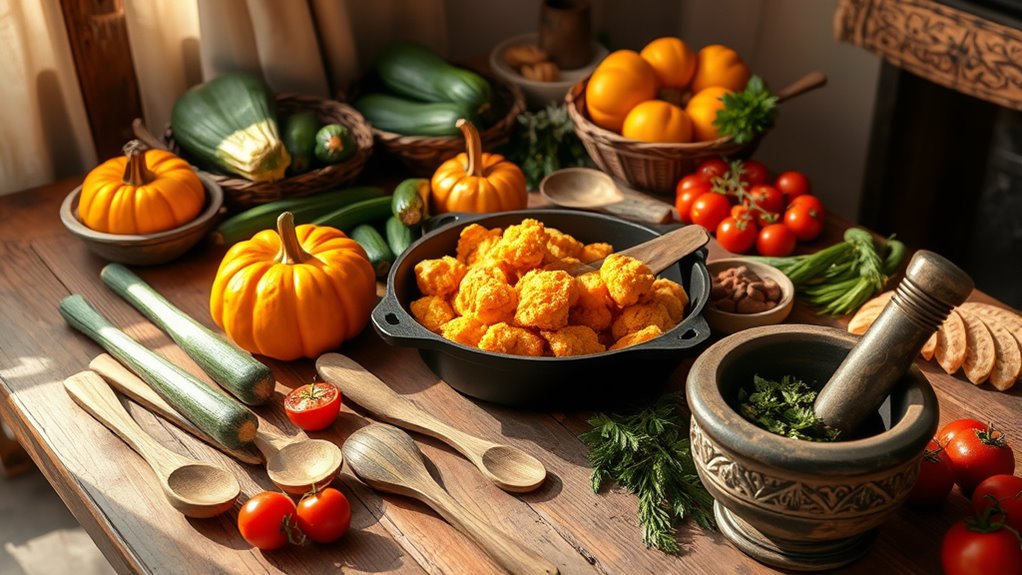Embracing seasonal slow food means focusing on local ingredients and traditional techniques that support sustainable farming and strengthen cultural roots. By shopping seasonally, you enjoy peak flavors while reducing waste and nurturing ecosystems. Foraging wild plants and using preservation methods like fermenting and canning deepen flavors and connect you to nature. This mindful approach encourages respect for the land and helps you create nourishing, meaningful meals—exploring more of these enriching practices is just ahead.
Key Takeaways
- Embracing seasonal slow food supports local farmers, enhances flavor, and nurtures a connection to land and tradition.
- Foraging techniques foster environmental awareness and uncover wild ingredients, enriching culinary creativity.
- Preserving methods like fermenting and drying extend ingredient lifespan and intensify natural flavors.
- Honoring culinary heritage through traditional techniques inspires innovation and deepens appreciation for local foods.
- Participating in seasonal food cycles promotes sustainability, mindful sourcing, and respectful engagement with ecosystems.

Have you ever considered how eating seasonal slow food can transform your culinary experience? When you choose ingredients that are in season, you’re not only supporting local farmers and ecosystems but also revealing flavors that are at their peak. It’s a way to connect more deeply with the land and tradition, making each meal a mindful celebration of nature’s rhythm. To do this effectively, you might explore foraging techniques—learning how to identify edible wild plants, herbs, and fungi safely. Foraging connects you to your surroundings and reveals ingredients often overlooked in grocery stores. It’s about more than just gathering; it’s about understanding the environment, respecting it, and harvesting with care. Once you gather your seasonal finds, preserving methods come into play, allowing you to enjoy the bounty long after its peak. Canning, fermenting, pickling, and drying are traditional techniques that extend the life of fresh produce while intensifying flavors. These preservation methods not only reduce waste but also deepen your appreciation for the ingredients’ natural qualities. When you preserve seasonal foods, you’re maintaining a taste of that specific time of year, making it possible to savor the flavors months later. This practice encourages patience and mindfulness, aligning with the slow food philosophy. You learn to value the process as much as the product, turning cooking into a ritual rather than a hurried task. Incorporating preserved foods into your meals enhances the depth and complexity of flavors, creating a richer, more meaningful dining experience. Moreover, mastering preserving methods can inspire you to experiment with traditional recipes handed down through generations, honoring culinary heritage. As you refine your foraging skills, you may discover new ingredients that inspire creative dishes, all rooted in seasonality. Additionally, employing budgeting tips such as planning ahead and negotiating for better deals can help you access high-quality ingredients without overspending. The act of harvesting, preserving, and preparing local ingredients fosters a greater respect for the environment and a deeper understanding of food’s journey from land to table. Embracing these practices not only elevates your cooking but also cultivates sustainability and authenticity. When you commit to seasonal slow food, you actively participate in a cycle that sustains local ecosystems and supports small-scale farmers. It’s a mindful approach that values quality over quantity and tradition over convenience. Ultimately, by integrating foraging techniques and preserving methods into your routine, you forge a more intimate and sustainable relationship with what you eat, making every meal a deliberate act of nourishment and celebration.
Frequently Asked Questions
How Can I Start Practicing Seasonal Slow Food at Home?
To practice seasonal slow food at home, start by exploring local markets for fresh, seasonal ingredients. Experiment with cooking with foraged ingredients like wild herbs or berries, and incorporate seasonal beverages such as herbal teas or fruit-infused waters. Plan meals around what’s in season, and take your time to prepare dishes using traditional methods. This approach helps you connect with nature’s rhythm while enjoying flavorful, wholesome meals.
What Are Some Common Tools for Traditional Food Preservation?
Imagine a treasure chest of tools that reveal the secrets of traditional preservation! You’ll need fermentation techniques like crocks and airlocks to transform vegetables into tangy delights. For drying methods, invest in dehydrators or simple sun-drying setups that turn water-laden produce into shelf-stable treats. These tools let you harness age-old wisdom, keeping local flavors vibrant and alive, ready to enjoy long after harvest celebrations fade away.
How Does Seasonal Eating Benefit Local Farmers?
You support local farmers by choosing seasonal eating, which boosts their sales at Farmers’ markets and encourages sustainable practices like crop rotation. When you buy what’s in season, farmers can plan better, reduce waste, and grow diverse crops, leading to healthier soil and more resilient farms. Your choices help maintain local agriculture, preserve traditional methods, and ensure fresh, flavorful food for your community.
Are There Specific Herbs That Complement Seasonal Ingredients?
Think of herbs as the cherry on top of seasonal flavor combinations. You’ll find that thyme pairs beautifully with spring vegetables, basil enhances summer tomatoes, and sage complements autumn squash. Herb pairings bring out the best in local ingredients, elevating your dishes to new heights. By choosing herbs that match the season, you create vibrant, fresh dishes that celebrate the natural bounty around you.
How Can I Adapt Recipes for Different Seasons Effectively?
You can adapt recipes for different seasons by making seasonal ingredient swaps that preserve seasonal flavors. Focus on using fresh, local produce available at each time of year, and adjust cooking methods accordingly. Incorporate herbs and spices that complement these ingredients to enhance flavor. This approach guarantees your dishes stay vibrant and true to the season, making your cooking more sustainable and delicious year-round.
Conclusion
By embracing seasonal slow food, you support local farmers and preserve traditional methods that keep flavors authentic. Did you know that consuming seasonal produce reduces your carbon footprint by up to 30%? So, next time you plan a meal, choose local ingredients and cherish the process of cooking with time-honored techniques. Not only will you enjoy richer flavors, but you’ll also contribute to a healthier planet and a more sustainable future.









